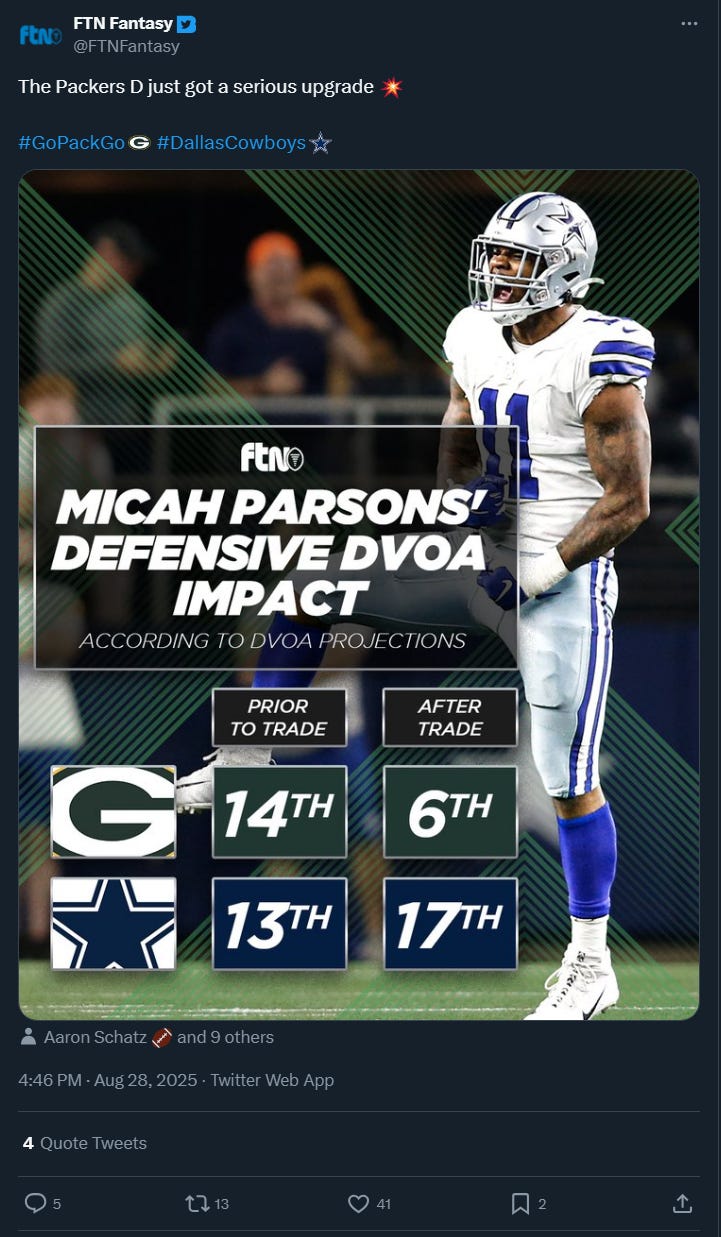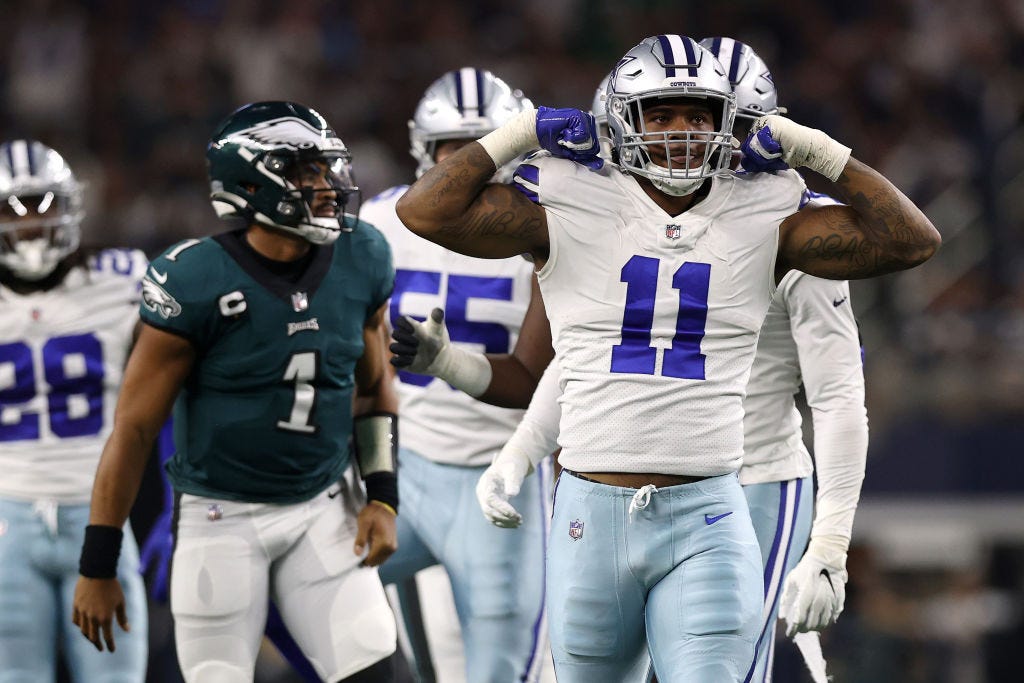Micah Parsons and the Value of One Player
The Dallas Cowboys traded Micah Parsons to the Green Bay Packers, who then gave him unprecedented money. Was it worth it? Can we tell?
How much can a non-quarterback matter?
After the Dallas Cowboys traded away superstar pass rusher Micah Parsons to the Green Bay Packers, it was reported that the Packers also agreed on a long-term deal for Parsons, worth up to $47 million per year, with about $30 million per year fully guaranteed.
Though the reported terms are inflated beyond what Parsons could reasonably see, the three-year cash flow for the player – probably the best way to evaluate the real leverage a player has – is perhaps the most dominant we’ve ever seen for a non-quarterback, even when adjusting for cap environment.
Going back to 2011, I compiled the top three-year cash flows for non-quarterback players. This data includes cash flows from one-year deals stacked on top of extensions and so on, not just the first three years of a particular contract.
As a reminder, cash flows are about the total amount of cash in hand players receive over a period of time — so they aren’t similar to Average Annual Value, where players may never see some of the money in the deal. Cash flow includes the whole signing bonus in the first year of acquired cash. That way, we can reasonably avoid geting tricked with cap accounting and artificially low “base” salaries.
Even though the Parsons numbers are “fluff,” they are nevertheless significant. His contract, in terms of inflation-adjusted three-year cash, is comparable to Kirk Cousins’ first three years with the Minnesota Vikings, Cam Newton’s contract right before his MVP year and Ben Roethlisberger’s new contract right after he led the league in passing yards in 2014.
Parsons has achieved quarterback money. Does he make a quarterback impact?
Can Defenders Be Quarterbacks?
How much difference can one defensive player make? There are a number of reasons that the defense is not like the offense, but a primary one is that the quarterback controls the offense in a way that no defensive player does on their side of the ball.
Although there are entanglement issues to work through, finding a relationship between a quarterback and their offensive performance is not difficult. Tom Brady and Peyton Manning both provided excellent test cases for what happens when quarterbacks leave teams and for what happens when they join new ones.
The teams they left cratered in performance, while the teams they joined immediately started scoring points – in some cases, setting records. We also see this when teams find their starting quarterbacks out due to injury.
For the above chart, I attempted to separately demarcate players who were benched for any reason, including end-of-season rest, and treated “bridge quarterbacks” for intended rookie starters as starters themselves (so those teams went from starter to starter instead of starter to unbenched backup). “Top Five” quarterbacks were decided on arbitrarily and “Top Five” injury replacements are injury replacements for “Top Five” QBs. I also excluded games where both the injured quarterback and starting quarterback threw at least ten passes.
Losing a starting quarterback drops a team in point production by nine or so points per game. That’s likely not the case for any defensive player. We can estimate a baseline for a defender, but it’s not going to be impressive.
The difference between the best defense in points per game (the Los Angeles Chargers) and the worst (Carolina Panthers) was 13.7 points. If we assume that these are the maximal outcomes for a defense – we can estimate that the difference between a typical defender and an injury replacement would be 13.7 divided by 11 (the number of defenders on the field, though we should recognize that subpackages make this remarkably imprecise).
When looking at it by EPA per play, the difference teases out to essentially 15.7 points per game over the course of the season between the best and worst defenses.
So, on average, maybe we can estimate the difference between a typical starter and a typical backup would be 1.2 to 1.4 points per game. This is an overestimate based on historical betting data, which suggests that only rare defensive players (about five percent) are worth a whole point or so in a game.

This might suggest that defensive coordinators are worth quite a bit more than we imagine and there may be threshold effects (e.g. one injury may not mean much, but three at one position group may mean quite a lot – more than three times the amount of one injury).
According to a 2016 Sports Insights piece, oddsmakers and bettors typically ignore individual defensive injuries, making rare exceptions. As one told author David Solar, “If there was any [defensive player that could move the line] it would be JJ Watt, Richard Sherman, Patrick Peterson, Josh Norman, or Von Miller.”
So we’re at a bit of an impasse – the difference between individual defenders is dwarfed by the value of a single quarterback, even average quarterbacks, where a salary like Parsons’ lands.
That’s not necessarily a case where the NFL and bettors or analytics disagree, however. Salary caps tend to impact high-value players more than median-value players. Lebron James, for example, might have made half of his ‘actual’ worth because of the nature of the NBA cap.
We can rely on some past speculation. In 2015, for example, Kevin Seifert asked executives and agents what Russell Wilson and Dez Bryant would make in uncapped leagues, arriving at values for both approximately 50 percent higher than they ended up receiving.
One former agent told the Washington Post in 2017 that Brady, a historically and intentionally underpaid quarterback, would be earning much more than twice what he actually made on an open, uncapped market (or, in the case of the 2016 contract environment, almost exactly double the top contract that year).
In either case, quarterback salaries would likely increase disproportionate to other salaries in an uncapped environment. That makes the question of whether X non-quarterback making “quarterback money” has as much of an impact as a quarterback a bit irrelevant. They don’t and it’s not really a failure of the market when it shakes out like that.
But Parsons at least makes a compelling argument for being one of the most impactful defenders the NFL has.
Keep reading with a 7-day free trial
Subscribe to Wide Left to keep reading this post and get 7 days of free access to the full post archives.



